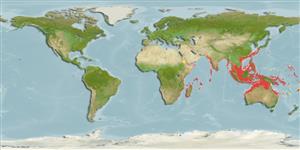Common names from other countries
Classification / Names / Names
народные названия | синонимы | Catalog of Fishes (gen., sp.) | ITIS | CoL | WoRMS
Environment: milieu / climate zone / depth range / distribution range
экология
; пределы глубины 0 - 250 m (Ref. 349). Tropical
Indo-West Pacific: from East Africa, including the Red Sea and the Persian Gulf, to eastern Indonesia; north to the Philippines and south to southern Indonesia.
Length at first maturity / Size / Вес / Возраст
Maturity: Lm ? range ? - ? cm Max length : 13.0 cm ShH самец/пол неопределен; (Ref. 349); common length : 10.0 cm SHW самец/пол неопределен; (Ref. 349)
Occasionally collected in shrimp trawls. Shell used in shellcraft (Ref. 349). Found on the bottoms of the continental shelf and upper slope. Also from shallow subtidal waters (Ref. 349). Members of the family Xenophoridae feed directly on sediments (Ref. 107881), collecting tiny detritus (Ref. 349) and foraminiferans (Ref. 104247).
Life cycle and mating behavior
половая зрелость | размножение | нерест | икра | Fecundity | личинки
Members of the order Neotaenioglossa are mostly gonochoric and broadcast spawners. Life cycle: Embryos develop into planktonic trocophore larvae and later into juvenile veligers before becoming fully grown adults.
Основная ссылка
ссылки | координатор | соавторы
Poutiers, J.M. 1998. (Ref. 349)
Статус Красного Списка МСОП (Ref. 130435)
Статус СИТЕС (Ref. 108899)
Not Evaluated
Not Evaluated
Угроза для людей
Harmless
Использование человеком
| FishSource |
инструменты
дополнительная информация
Возраст/РазмерыростЗависимость между длиной и массой телаЗависимость между длинамиморфологияличинкичисленность
ресурсы в Интернет
Estimates based on models
Preferred temperature
(Ref.
115969): 23.1 - 28.6, mean 27.3 (based on 918 cells).
Уязвимость
Low vulnerability (10 of 100).
Категория цены
Unknown.
